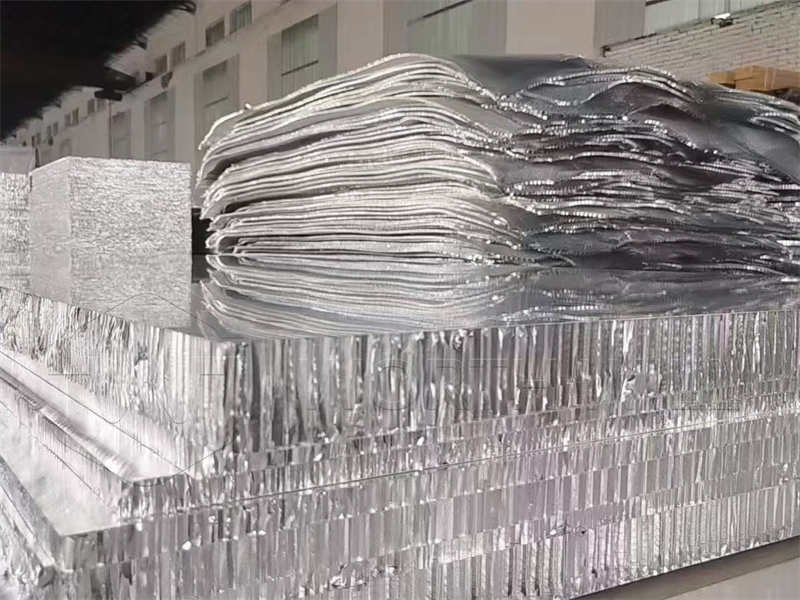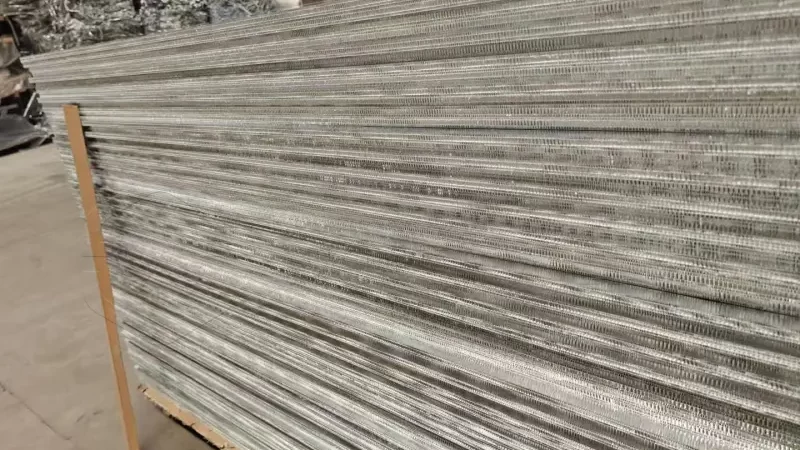Introduction to Aluminium Honeycomb Manufacturing
The aluminium honeycomb manufacturing process transforms raw aluminium alloy into lightweight, high-strength honeycomb core material through precision engineering and advanced technology. This complex process involves multiple stages of fabrication, bonding, and finishing to create the hexagonal cell structure that gives honeycomb its exceptional strength-to-weight ratio.


Key Stages of Honeycomb Manufacturing
| Manufacturing Stage | Process Description | Equipment Used | Quality Control Check |
|---|---|---|---|
| 1. Alloy Selection | Choosing appropriate aluminium grades | Material testing instruments | Chemical composition verification |
| 2. Foil Production | Rolling aluminium to precise thickness | Cold rolling mills | Thickness tolerance ±0.01mm |
| 3. Corrugation | Forming hexagonal pattern | Corrugating machines | Cell size consistency check |
| 4. Stacking | Layering corrugated sheets | Automated stacking systems | Layer alignment verification |
| 5. Bonding | Adhesive application and curing | Adhesive applicators, curing ovens | Bond strength testing |
| 6. Expansion | Stretching bonded block | Expansion machines | Cell uniformity inspection |
| 7. Slicing | Cutting to required thickness | CNC slicing machines | Thickness tolerance ±0.1mm |
| 8. Finishing | Surface treatment and coating | Coating lines | Surface quality inspection |
Detailed Manufacturing Process Breakdown
1. Raw Material Preparation
- Aluminium Alloys Used: 3003, 5052, 6061 (most common)
- Foil Thickness Range: 0.02mm – 0.2mm
- Width Requirements: 500mm – 1300mm
- Surface Treatment: Cleaning and pre-treatment
2. Foil Corrugation Process
- Corrugation Methods:
- Rotary corrugation
- Press corrugation
- Cell Size Options: 3mm – 25mm
- Corrugation Depth: 0.5mm – 10mm
- Tolerance: ±0.05mm
3. Adhesive Bonding Technology
| Adhesive Type | Curing Temperature | Curing Time | Shear Strength |
|---|---|---|---|
| Epoxy Resin | 120°C – 180°C | 30-60 minutes | 3.5-5.0 MPa |
| Phenolic Resin | 140°C – 200°C | 45-90 minutes | 4.0-6.0 MPa |
| Polyimide | 200°C – 250°C | 60-120 minutes | 5.0-7.0 MPa |
4. Expansion and Slicing
- Expansion Methods:
- Mechanical expansion
- Hydraulic expansion
- Slicing Techniques:
- Band saw cutting
- Wire cutting
- CNC machining
- Thickness Range: 3mm – 200mm
- Tolerance: ±0.1mm to ±0.5mm
Quality Control Parameters
| Parameter | Standard Value | Testing Method | Acceptance Criteria |
|---|---|---|---|
| Cell Size | 3-25mm | Optical measurement | ±0.1mm tolerance |
| Density | 25-150 kg/m³ | Weight/volume measurement | ±5% of specification |
| Compression Strength | 1-15 MPa | ASTM C365 | ±10% of specification |
| Shear Strength | 1-4 MPa | ASTM C273 | ±10% of specification |
| Flatness | 0.5-2.0 mm/m | Surface plate testing | Max 2mm/m |
Technical Specifications of Finished Honeycomb
| Property | Standard Grade | Aerospace Grade | Marine Grade |
|---|---|---|---|
| Density (kg/m³) | 35-75 | 25-50 | 45-85 |
| Compression Strength (MPa) | 2.0-7.0 | 1.5-5.0 | 3.0-8.0 |
| Shear Strength (MPa) | 1.2-2.5 | 1.0-2.0 | 1.5-3.0 |
| Temperature Resistance | -50°C to 150°C | -60°C to 200°C | -40°C to 100°C |
| Cell Size (mm) | 6-12 | 3-8 | 8-16 |
Manufacturing Equipment Overview
- Rolling Mills: Precision foil production
- Corrugating Machines: Hexagonal pattern formation
- Adhesive Applicators: Precise glue deposition
- Curing Ovens: Temperature-controlled bonding
- Expansion Machines: Uniform cell opening
- CNC Slicers: Precision thickness cutting
- Quality Control Instruments: Automated inspection systems
Environmental Considerations
- Energy Consumption: 15-25 kWh/kg of honeycomb produced
- Waste Reduction: 95%+ material utilization
- Recyclability: 100% aluminium recyclable
- Emissions Control: Closed-loop systems
- Water Usage: Minimal water requirements
What is Aluminium Honeycomb?
Before diving into the process, let’s understand what aluminium honeycomb is. Imagine a beehive – a structure made of many small, hexagonal cells. Aluminium honeycomb mimics this natural design. It’s a lightweight core material made from thin aluminium foil that is formed into a series of open, hexagonal cells. When sandwiched between two outer skin materials, it creates a honeycomb panel with exceptional stiffness, minimal weight, and high impact resistance. These properties make it an invaluable component in industries where every gram matters.
The Aluminium Honeycomb Manufacturing Process: Step-by-Step
The creation of aluminium honeycomb cores is a precise and carefully controlled sequence of operations. Here’s a detailed look at each stage:
Step 1: Raw Material Selection – High-Quality Aluminium Foil
The journey begins with the selection of the right raw material: aluminium foil. The quality and properties of this foil are critical to the final product’s performance.
- Common Alloys: Typically, alloys from the 3000 series (e.g., 3003) or 5000 series (e.g., 5052) are used. These alloys offer a good balance of strength, formability, and corrosion resistance.
- Foil Thickness: The foil is extremely thin, often ranging from 0.04 mm to 0.1 mm. This thinness is crucial for achieving the lightweight nature of the honeycomb.
Step 2: Adhesive Application – The Bonding Foundation
Once the foil is selected, the next critical step is the precise application of adhesive.
- Adhesive Type: High-performance epoxy resins or thermosetting adhesives are typically used. These adhesives are designed to provide strong, durable bonds that can withstand various environmental conditions.
- Precision Coating: A series of parallel adhesive lines are applied to the surface of the aluminium foil at very specific, regular intervals. The accuracy of this spacing directly determines the cell size of the future honeycomb.
Step 3: Stacking and Pressing – Forming the Honeycomb Block
With the adhesive applied, multiple layers of the treated foil are carefully stacked on top of each other.
- Layering: The foil strips are stacked in an alternating pattern, ensuring that the adhesive lines on one layer align with the non-glued areas of the adjacent layer.
- Curing: The stacked layers are then placed into a large press. Under controlled heat and pressure, the adhesive cures, bonding the layers together. This forms a solid, unexpanded honeycomb block, often called a “loaf” or “ingot.” At this stage, the block resembles a series of wavy, bonded foil sheets.
Step 4: Slicing the Block – Achieving Desired Thickness
The cured honeycomb block is now ready to be cut into individual unexpanded sheets.
- Precision Slicing: Specialized slicing machines, often using large bandsaws, cut the block into sheets of the desired final honeycomb thickness. This is a critical step for maintaining consistent cell height across the finished product.
- Thickness Control: The accuracy of the slicing ensures that when the honeycomb is expanded, each cell will have a uniform depth.
Step 5: Expansion – The Transformation to Honeycomb Structure
This is the most visually striking part of the aluminium honeycomb manufacturing process.
- Mechanical Expansion: The sliced, unexpanded sheets are carefully pulled apart by a special expansion machine.
- Controlled Expansion: The expansion process must be precise to ensure uniform cell shape and size throughout the core. This step essentially “opens” the closed block into the familiar open-cell aluminium honeycomb core.
Step 6: Quality Control and Finishing – Ensuring Perfection
After expansion, the aluminium honeycomb cores undergo rigorous quality checks and final processing.
- Visual Inspection: Each expanded sheet is inspected for any defects, such as irregular cell formation, damaged foil, or inconsistent expansion.
- Dimensional Accuracy: The core is measured to ensure it meets specified dimensions, including thickness, cell size, and overall panel size.
- Cutting to Size: The expanded core is then cut to the exact dimensions required by the customer.
- Optional Treatments: Depending on the application, the honeycomb might undergo additional treatments like cleaning or coating.
Key Parameters in Aluminium Honeycomb Manufacturing
The properties of the final aluminium honeycomb core are by several key parameters established during its manufacturing process:
Cell Size
The cell size refers to the distance between two opposite cell walls within the hexagonal structure.
| Cell Size (mm) | Impact on Properties | Typical Applications |
|---|---|---|
| 3.2 (1/8 inch) | Higher density, higher compressive strength, higher shear strength | Aircraft leading edges, high-stress areas |
| 6.4 (1/4 inch) | Good balance of strength and weight | Standard aircraft interiors, rail panels |
| 9.6 (3/8 inch) | Lower density, lighter weight, good for larger panels | Large architectural panels, boat interiors |
| 19.1 (3/4 inch) | Very low density, maximum weight savings | Non-structural infill, acoustic panels |
Smaller cell sizes generally lead to higher density, greater compressive strength, and higher shear strength.
Foil Thickness
| Foil Thickness (mm) | Impact on Properties | Typical Applications |
|---|---|---|
| 0.04 | Lowest weight, good for non-structural, lightweight parts | Interior aircraft components, decorative panels |
| 0.06 | Standard choice, balanced strength and weight | General aerospace, automotive, marine |
| 0.08 | Higher strength, more robust cores | High-load panels, flooring |
Thicker foil results in a stronger, denser core, while thinner foil yields a lighter, more flexible core.
Core Density
The core density (weight per unit volume) is a direct result of the cell size and foil thickness. It’s a critical factor in determining the overall weight and mechanical properties of the honeycomb panel.
Applications of Manufactured Honeycomb
- Aerospace:
- Aircraft flooring
- Satellite structures
- Rocket components
- Interior panels
- Transportation:
- High-speed trains
- Marine vessels
- Automotive panels
- RV interiors
- Construction:
- Architectural panels
- Doors and partitions
- Elevator interiors
- Solar panel backing
- Industrial:
- Machine platforms
- Work surfaces
- Exhibition stands
- Clean room partitions
Advanced Manufacturing Techniques
- Laser Cutting: Precision cell size control
- Automated Inspection: Machine vision quality control
- Robotic Handling: Reduced human intervention
- IoT Monitoring: Real-time process monitoring
- Custom Alloy Development: Application-specific formulations
Troubleshooting Common Manufacturing Issues
| Issue | Cause | Solution |
|---|---|---|
| Cell deformation | Improper expansion | Adjust expansion parameters |
| Adhesive failure | Incorrect curing | Optimize temperature/time |
| Thickness variation | Slicing error | Calibrate cutting equipment |
| Surface defects | Contamination | Improve cleaning process |
| Density inconsistency | Foil thickness variation | Enhance rolling control |
Future Trends in Honeycomb Manufacturing
- Nanotechnology: Enhanced material properties
- Automation: Fully automated production lines
- Sustainability: Reduced energy consumption
- Customization: Application-specific designs
- Digitalization: AI-powered quality control
FAQ
Q: What is the minimum cell size achievable?
A: 2mm cell size is possible with precision manufacturing equipment.
Q: How long does the manufacturing process take?
A: Complete process typically takes 2-5 days depending on specifications.
Q: Can custom cell shapes be produced?
A: Yes, hexagonal is standard but other shapes are possible.
Q: What is the maximum panel size available?
A: Standard panels up to 2500mm x 6000mm, larger sizes possible.
Q: Is the process environmentally friendly?
A: Yes, aluminium is fully recyclable and modern plants minimize waste.
Why the Manufacturing Process Matters
The detailed and precise aluminium honeycomb manufacturing process is not just about creating a product; it’s about engineering performance. Every step, from foil selection to expansion, directly impacts the honeycomb’s integrity, strength, and suitability for demanding applications. A well-controlled process ensures consistent quality, reliability, and the ability to customize the core to meet specific design requirements, making it a cornerstone of lightweight material technology.
The future of honeycomb manufacturing lies in increased automation, improved sustainability, and enhanced customization capabilities. As technology advances, we can expect even better performance characteristics and more efficient production methods.
For architects, engineers, and designers, understanding the manufacturing process helps in selecting the right honeycomb product for specific applications and ensures optimal performance in final products.
